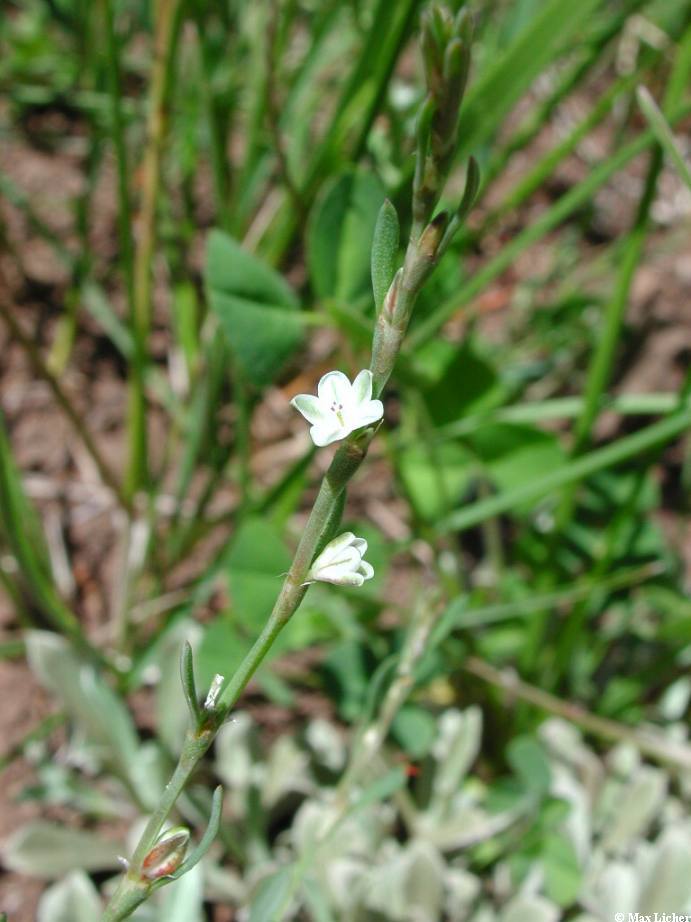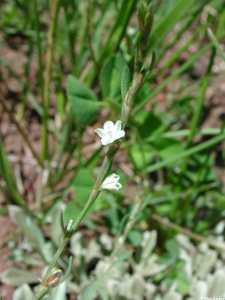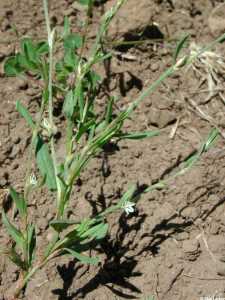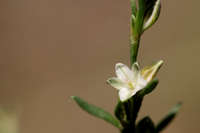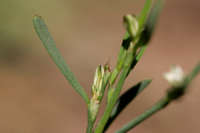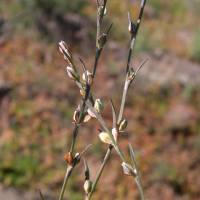Herbs. Stems erect, green, simple or branched, not wiry, 5-80 cm, glabrous or sparsely papillose-scabridulous. Leaves uniformly distributed, articulated to ocreae, basal leaves caducous, distal leaves abruptly reduced to bracts; ocrea 6-12 mm, glabrous or minutely papillose-scabridulous, proximal part cylindric, distal part hyaline, lacerate; petiole 0.1-2 mm; blade 1-veined, not pleated, linear, narrow-oblong, or oblanceolate, 15-55 × 2-8(-12) mm, margins revolute, smooth or papillose-denticulate; apex acute to mucronate. Inflorescences axillary and terminal, spikelike, elongate; cymes widely spaced along branches, 2-4-flowered. Pedicels mostly exserted from ocreae, reflexed, 2-6 mm. Flowers closed; perianth 3-4.5 mm; tube 20-28% of perianth length; tepals overlapping, green to tannish with white or pink margins, petaloid, oblong, cucullate, navicular, apex rounded; midveins usually branched, rarely unbranched; stamens 8. Achenes enclosed in perianth, black, elliptic or oblong to ovate, 3-4(-4.5) mm, faces subequal, shiny or dull, smooth or minutely striate-tubercled.
Flowering Jun-Oct. Dry, often disturbed places, rock outcrops, sandy ground; 300-3000 m; Alta., B.C., Man., Ont., Que., Sask., Yukon; Ariz., Calif., Colo., Idaho, Iowa, Mich., Minn., Mont., Nebr., Nev., N.H., N.Mex., N.Y., Oreg., S.Dak., Utah, Vt., Va., Wash., Wyo.
Five taxa that have been included in Polygonum douglasii (E. Murray 1982; J. C. Hickman 1984; J. T. Kartesz and K. N. Gandhi 1990) are treated here as distinct species: P. austiniae, P. majus, P. nuttallii, P. sawatchense, and P. spergulariiforme. Hickman noted extensive intergradation and numerous intermediate specimens among those sympatric elements, but qualitative or quantitative characters allow reliable discrimination in most cases (M. Costea and F. J. Tardif 2005), and species are here circumscribed similar to C. L. Hitchcock (1964).
Greene described var. latifolium as having leaf blades and achenes broader than those of var. douglasii. C. L. Hitchcock (1964) recognized the former, but the characters used to distinguish it appear to vary continuously, and reliable separation is not possible.
Duration: Annual
Lifeform: Forb/Herb
General: Annual, 5-80 cm tall; stems erect, simple or branched, 4- angled, glabrous or sometimes minutely scabrous; taprooted.
Leaves: Basal (falling early) and cauline, alternate, linear, narrowly oblong or lanceolate, 1-5.5 cm long, 2-8 mm wide, glabrous, 1-veined, margins rolled under, sometimes minutely dentate; ocrea 6-12 mm long, the lower part cylindric, silvery and membranous towards the apex; petiole 0.1-2 mm long.
Flowers: Inflorescence of axillary cymes, uniformly distributed or clustered at the tips of branches and stems, 2-8 flowered; pedicels 1-5 mm long; perianth 2-5 mm long, tepals 5, overlapping, green with pink, red, or white margins; stamens 5-8, the anthers whitish yellow; flowers April-October.
Fruits: Achene, elliptic, oblong, or ovate, 3-angled, 3-4.5 mm long, black, smooth or bearing minute tubercles, shiny or dull.
Ecology: Ponderosa pine forests, dry habitats, open rocky sites, sandy soils; 1700-2900 m (5500-9500 ft); Apache, Coconino, Gila, Graham, Greenlee, Mohave, Navajo, Pima, Pinal, and Yavapai counties; Canada, northeastern, north- central, western, and southwestern U
Notes: Polygonum sawatchense ( Johnston-s knotweed) is very similar to P. douglasii, distinguished primarily by its erect pedicels. It occurs in similar habitats. Ours is ssp. sawatchense [=P. douglasii ssp. johnstonii]. Polygonum polygaloides (milkwort knotweed) is differentiated by its tepals with acute to acuminate tips; and achenes light yellow, light brown, greenish to dark brown, smooth or with longitudinal ridges. It occurs in seeps and other wet habitats, in mountain meadows, and on dry subalpine slopes. Ours is ssp. kelloggii [=P. kelloggii]. Polygonum douglasii is a host plant for the purplish copper butterfly.
Editor: Springer et al. 2008
Slender annual, 2-6 dm, with numerous ascending branches; lvs linear-oblong to narrowly lanceolate, 2-5 cm נ2-8 mm, subulate-tipped, flat, often somewhat revolute; fls remote, only 1-3 per ocrea; pedicels 2-3 mm, exsert and soon reflexed; perianth 3-4 mm, cleft nearly to the base; achene black, shiny, 3-4 mm; 2n=40. Open, rocky or gravelly soil; Que. and n. N. Engl. to ne. Minn. and Io.; widespread in w. U.S.
Gleason, Henry A. & Cronquist, Arthur J. 1991. Manual of vascular plants of northeastern United States and adjacent Canada. lxxv + 910 pp.
©The New York Botanical Garden. All rights reserved. Used by permission.


